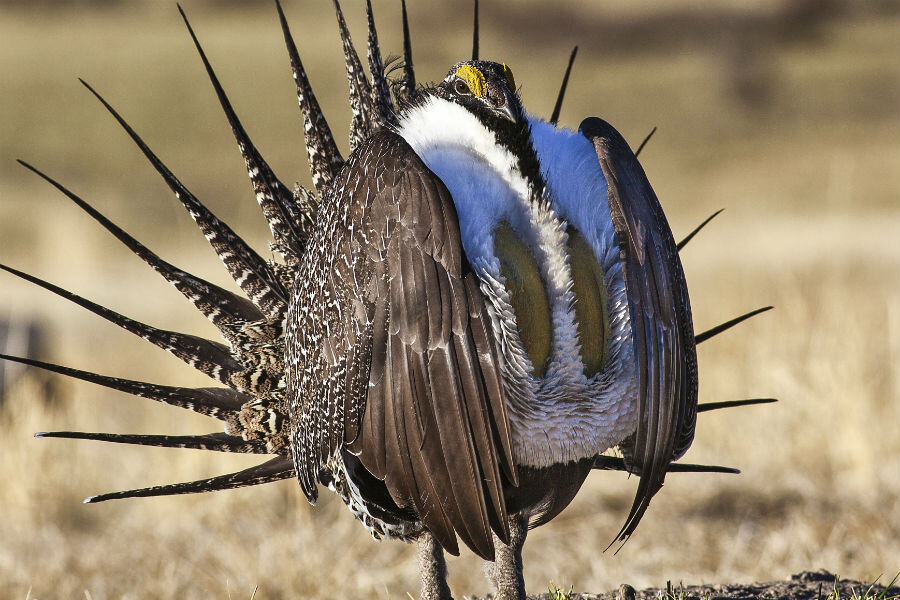In sage grouse plan, vision of conservation that industry can embrace
The Obama administration announced Tuesday that it would not place the greater sage grouse on the list of federally protected animals. The decision was a rare one hailed by both environmentalists and the energy industry as good news – for both the bird and the Western states it calls home.
Instead of relying on the Endangered Species Act, a broad coalition of public and private stakeholders will collaborate to protect the animal and its habitat.
The fate of the greater sage grouse and its sweeping habitat – which crosses 11 states in the western United States – once threatened to drive another wedge between environmentalists, the energy industry, and government regulators. But on Tuesday, some experts said the plan could provide a model for other conservation and energy development fights in the future.
In passing up the chance to protect the greater sage grouse under the Endangered Species Act, the federal government has taken the hard road, experts say, pouring millions of dollars into developing a vast plan to protect the bird, its habitat, and state economies reliant on mining, drilling, and cattle grazing.
"I have a hard time thinking of another example or another species that has prompted this scale of planning and collaboration," says Chris Saeger, director of the Western Values Project.
Interior Department Secretary Sally Jewell credited the “extraordinary collaboration” of governors, ranchers, environmental groups, the extraction industry, and federal agencies.
“This is truly a historic effort,” she said in a statement, describing the years-long deliberations as the largest conservation effort in US history.
The Bureau of Land Management is putting the finishing touches on more than 90 land-use strategies to steer mining, drilling, and cattle grazing away from areas where sage grouse are likely to congregate. But experts say that it will be up to local officials and businesses to ensure that the dozens of different plans are giving the bird robust protection.
Those local constituencies “found some space to chart a path of real balance, and those are the people who are going to be responsible for seeing this through to implementation,” says Mr. Saeger.
“Those aren’t always the voices that capture the most attention,” he adds, “but they are the voices that get the most done, and hopefully that’s how the bulk of this progress continues to happen.”
Tuesday’s announcement ends a years-long wait to see if the US Fish and Wildlife Service would list the sage grouse as an endangered species. It had until Sept. 30 to make a decision on the bird, which has seen its population has plummet from several million to between 200,000 and 500,000, according to federal officials. While ESA protection can rescue a species from the brink of extinction, it often comes at a cost, with the local economy burdened by onerous emergency regulations.
And while a conservation issue as vast and complex as the sage grouse will be a rare occurrence, other experts think the collaborative approach can be replicated on smaller scale – provided all the stakeholders have enough time to reach a compromise.
“We’re seeing for the first time on a big scale everyone recognize that we’re better off acting earlier than later, before the ESA triggers very limited options,” said David Hayes, a visiting senior fellow at the Center for American Progress, in a phone interview.
Mr. Hayes, who also served as deputy secretary of the Interior under Presidents Obama and Clinton, adds, “As long as there’s advanced warning that a species is in trouble then this sage grouse framework provides I think a very constructive way to enable dealing with a species before they’re on the brink.”
This act-early, collaborative model is already being applied to the leasing of western public lands for oil and gas development. The agencies are bringing different stakeholders together for conversations before granting leases. The goal is to determine how and where drilling can occur in a way that protects both environmental and business interests.
What the agencies have accomplished with the sage grouse plan, Saeger says, they are now doing “on a smaller, more focused, more regional scale, and they deserve a lot of credit for it.”
Federal agencies used a similar collaborative approach to plan solar energy farms on public lands across six states. And it could be applied to other issues, as well.
“This could be a model for how we look at recreation in central Idaho, or how we look at watershed management across state and federal lands in Colorado,” says Nada Culver, a senior director at The Wilderness Society.
Not everyone was hailing Tuesday's decision as a victory for either the sage grouse or compromise. Some environmental groups threatened to file lawsuits, saying the plan leaves too many loopholes that energy companies could exploit. Some energy companies say the plan is too restrictive.
Most conservation fights in the future won’t represent the jurisdictional nightmare the sage grouse has. But that is part of its success.
“We’ve seen things addressed federally or state by state, field office by field office,” says Ms. Culver. “It’s never quite been at this scale or this level of detail.”
“If you can do this for the sage grouse, of course you can do this for another species and another conservation issues,” she adds. “Is everyone going to be happy? No, but it’s certainly a great model that we hope can continue and be refined.”







